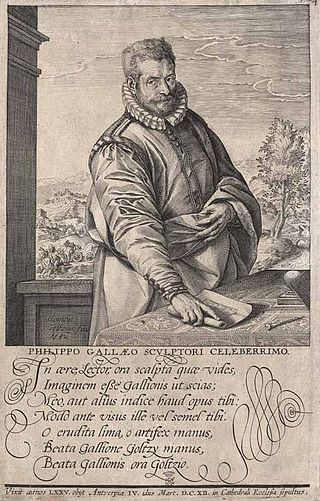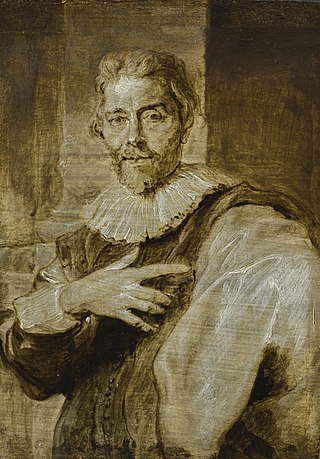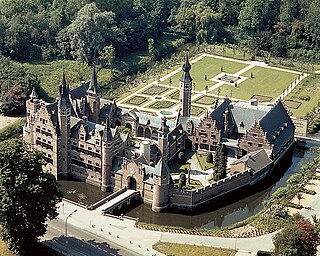Related Research Articles

Isabella Clara Eugenia, sometimes referred to as Clara Isabella Eugenia, was sovereign of the Spanish Netherlands, which comprised the Low Countries and the north of modern France with her husband, Archduke Albert VII of Austria.

Maria Josepha of Austria was the Queen of Poland, Grand Duchess of Lithuania and Electress of Saxony by marriage to Augustus III. From 1711 to 1717, she was heir presumptive to the Habsburg monarchy.

PhilipGalle was a Dutch publisher, best known for publishing old master prints, which he also produced as designer and engraver. He is especially known for his reproductive engravings of paintings.

Maria Amalia of Austria was Holy Roman empress, queen of Bohemia, and electress of Bavaria among many other titles as the spouse of Emperor Charles VII. By birth, she was an archduchess of Austria as the daughter of Emperor Joseph I. One of her children was Maximilian III Joseph, Elector of Bavaria.

Princess Maria Theresia of Liechtenstein was the heiress to the Silesian Duchy of Troppau. Countess of Soissons by marriage, she was the last person to hold the title. She had one son who predeceased her in 1734. Her son was engaged to Maria Teresa Cybo-Malaspina, sovereign duchess of Massa and princess of Carrara.

Maria Sofia De la Gardie was a Swedish noble, countess, courtier, banker and industrialist entrepreneur. She is most known for her industrial enterprises, and she has been referred to as the first female grand entrepreneur of her country. She served as överhovmästarinna to Queen Christina of Sweden.

Sir Peter Paul Rubens was a Flemish artist and diplomat. He is considered the most influential artist of the Flemish Baroque tradition. Rubens' highly charged compositions reference erudite aspects of classical and Christian history. His unique and immensely popular Baroque style emphasised movement, colour, and sensuality, which followed the immediate, dramatic artistic style promoted in the Counter-Reformation. Rubens was a painter producing altarpieces, portraits, landscapes, and history paintings of mythological and allegorical subjects. He was also a prolific designer of cartoons for the Flemish tapestry workshops and of frontispieces for the publishers in Antwerp.

Jan Baptist Barbé or Jan-Baptist Barbé (1578–1649) was a Flemish engraver, publisher and art dealer active in Antwerp. He is known for his engravings after his own designs as well as for his reproductive engravings.

Pieter Faes or Peeter Faes was a Flemish painter of still lifes of flowers and fruit. He worked in a decorative style close to that of Jan van Huysum.

The Sterckshof castle is in Deurne, Antwerp, Belgium. From 1994 to 2014 it housed the Sterckshof silver museum of the Province of Antwerp. Built on the site of a much older castle, or great house, the present building is a reconstruction erected in the 1920s.

Jan Baptist Huysmans was a Flemish painter active in Antwerp who is known for his Italianate and arcadian landscapes and architectural capricci.

Jan van Buken or Jan van Beucken was a Flemish painter mainly known for his genre paintings and still lifes.

Jan Rubens (1530–1587) was a Flemish lawyer and city administrator of Antwerp, then located in the Spanish Netherlands. A convert to Calvinism, he fled Antwerp with his family because of the suppression of Protestantism in the Spanish Netherlands and settled in Cologne. He was imprisoned in 1571 because of an affair with his client Anna of Saxony, the second wife of William I of Orange, the leader of the Protestant resistance against the Spanish king who ruled the Spanish Netherlands. He was later released but required to remain in Siegen. He returned to Cologne with his family only in 1578. Rubens is considered to be the natural father of Christine von Diez, the daughter of Anna of Saxony, who was born in Siegen in 1571.
Elisabet Fritz née Lenström, also known as Elisabet Renat was a Swedish industrialist. She managed the Fritz Silk Factory in Stockholm from 1737 to 1749, which had been founded by her late spouse as one of the first silk factories in Stockholm, and which was one of the biggest and most successful of the Swedish silk industry under her leadership in the mid 18th-century.

Jan Baptist Nollekens was a Flemish painter specialised in genre and still life paintings. His genre paintings depict scenes of drinkers, card players, peasants, merry companies and artist studios. His known still life paintings are hunting pieces. He was active in Flanders, the Dutch Republic, England and France.

Martina Plantin (1550–1616) was involved in her father's printing business from five years of age, and ran the family lace shop from the age of 17. After her father and husband had died, she was the head of the Plantin-Moretus printing business from 1610 to 1614, with daily operations managed by her sons Balthasar and Jan. She was considered a "formidable businesswoman from the wealthy bourgeoisie" and the head of the Plantin-Moretus printing dynasty, by marrying Jan Moretus and being the daughter of publisher Christophe Plantin.

Willem Kerricx or Willem Kerricx the Elder was a Flemish sculptor active in Antwerp. His works comprise mostly sculptured church furniture, individual sculptures, both portrait busts as well as statues of saints for churches and funerary monuments. His style shows the transition from the highly dramatic expressiveness of the Antwerp late Baroque towards a more gracious and elegant Rococo style. He operated a large workshop in Antwerp which was continued by his son into the middle of the 18th century.

Albert Xavery, Albert Saverij or Albertus Xavery was a Flemish sculptor principally active in Antwerp. He produced mainly statues of mythological figures, some of them on a large scale, made to be displayed in luxurious residences or in gardens. Like other Antwerp sculptors, he exported many of his works to the Dutch Republic, where his patrons included members of the House of Nassau.
Frans Van Dijk was a Belgian architect. He was an important representative of eclecticism in architecture.
Madame Malotteau, was the mayor of Namur in the Austrian Netherlands between 1734 and 1749. She was likely the first woman to execute the office of mayor in the world.
References
- Petra Rebmann, Het Rivierenhof, vijf eeuwen parkgeschiedenis, Lanno, Tielt, 1997, ISBN 9020930974